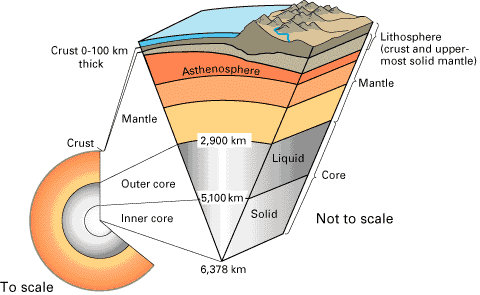Review It
Now it is time to review the skill of integrating quantitative and qualitative information with visual information by analyzing a short excerpt from the article and its matching diagram piece by piece. Remember to do the following as you review:
- Read for key qualitative and quantitative information.
- Look for ways that this information is clarified by the diagram.

A diagram of the earth’s layers can provides us with both qualitative and quantitative information.
Image Credit: USGSopens in new window
The Earth's Layers
The Earth is a layered planet consisting of crust, mantle, and an inner and outer core. Approximately 100 km of the outermost part is a rigid layer called the lithosphere, which includes the crust and uppermost mantle. This lithosphere is broken into a number of large and small plates (slabs) that move over a ‘plastic’ (more accurately called viscoelastic) layer in the upper mantle called the asthenosphere. The movement of these plates is called plate tectonics.
Now, go to the “Plate Boundaries”opens in new window article and view “The Earth’s Layers” diagram on page 3 that accompanies the text and answer the questions below.
What main idea from the text is illustrated by the diagram?
What quantitative data from the text is illustrated by the top two sections (dark brown and light brown) in the diagram?
What qualitative data from the text is illustrated by the third section (bright orange) in the diagram?
What specific quantitative data is shown only in the diagram and not in the text?








